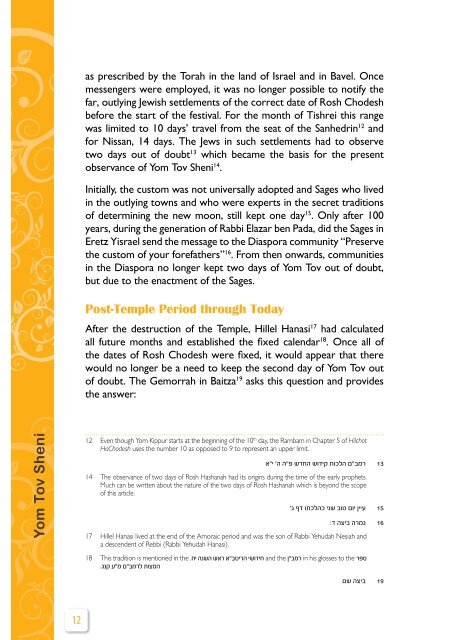Y om T o v Sheni Yom Tov Sheni - Chidushei Torah@NDS
Y om T o v Sheni Yom Tov Sheni - Chidushei Torah@NDS
Y om T o v Sheni Yom Tov Sheni - Chidushei Torah@NDS
You also want an ePaper? Increase the reach of your titles
YUMPU automatically turns print PDFs into web optimized ePapers that Google loves.
Y<strong>om</strong> <strong>Tov</strong> <strong>Sheni</strong><br />
12<br />
as prescribed by the Torah in the land of Israel and in Bavel. Once<br />
messengers were employed, it was no longer possible to notify the<br />
far, outlying Jewish settlements of the correct date of Rosh Chodesh<br />
before the start of the festival. For the month of Tishrei this range<br />
was limited to 10 days’ travel fr<strong>om</strong> the seat of the Sanhedrin 12 and<br />
for Nissan, 14 days. The Jews in such settlements had to observe<br />
two days out of doubt 13 which became the basis for the present<br />
observance of Y<strong>om</strong> <strong>Tov</strong> <strong>Sheni</strong> 14 .<br />
Initially, the cust<strong>om</strong> was not universally adopted and Sages who lived<br />
in the outlying towns and who were experts in the secret traditions<br />
of determining the new moon, still kept one day 15 . Only after 100<br />
years, during the generation of Rabbi Elazar ben Pada, did the Sages in<br />
Eretz Yisrael send the message to the Diaspora c<strong>om</strong>munity “Preserve<br />
the cust<strong>om</strong> of your forefathers” 16 . Fr<strong>om</strong> then onwards, c<strong>om</strong>munities<br />
in the Diaspora no longer kept two days of Y<strong>om</strong> <strong>Tov</strong> out of doubt,<br />
but due to the enactment of the Sages.<br />
Post-Temple Period through Today<br />
After the destruction of the Temple, Hillel Hanasi 17 had calculated<br />
all future months and established the fixed calendar 18 . Once all of<br />
the dates of Rosh Chodesh were fixed, it would appear that there<br />
would no longer be a need to keep the second day of Y<strong>om</strong> <strong>Tov</strong> out<br />
of doubt. The Gemorrah in Baitza 19 asks this question and provides<br />
the answer:<br />
12 Even though Y<strong>om</strong> Kippur starts at the beginning of the 10 th day, the Rambam in Chapter 5 of Hilchot<br />
HaChodesh uses the number 10 as opposed to 9 to represent an upper limit.<br />
א”י ’ה ה”פ שדחה שודיק תוכלה ם”במר 13<br />
14 The observance of two days of Rosh Hashanah had its origins during the time of the early prophets.<br />
Much can be written about the nature of the two days of Rosh Hashanah which is beyond the scope<br />
of this article.<br />
’ג ףד ותכלהכ ינש בוט םוי ןייע 15<br />
:ד הציב הרמג 16<br />
17 Hillel Hanasi lived at the end of the Amoraic period and was the son of Rabbi Yehudah Nesiah and<br />
a descendent of Rebbi (Rabbi Yehudah Hanasi).<br />
18 This tradition is mentioned in the .חי הנשה שאר א”בטירה ישודיח and the ן”במר in his glosses to the רפס<br />
.גנק ע”מ ם”במרל תוצמה<br />
םש הציב 19


